17 Types of Pizza You Should Try in 2025
Introduction
Discover the magic of pizza with our 2025 guide to the most iconic and trending types of pizza around the world.
From TikTok-viral pizza bowls to air fryer Neapolitan hacks, this refreshed edition blends timeless classics with the latest pizza trends that food lovers can’t get enough of.
Whether you’re a cheese-pull chaser or a thin-crust purist, this guide is your fresh slice of inspiration — updated for today’s cravings. We’ll explore the most beloved types of pizza, their origins, and how to recreate them at home with flair.
Why Pizza Is a Global Favorite
Pizza is one of the most beloved foods worldwide, and this guide explores why it has become a staple in so many cultures. Its universal appeal lies in its versatility — whether it’s a thin, crispy Neapolitan pizza or a thick, cheesy Chicago deep-dish, there’s a type of pizza for every taste.
🍕 Trending Now on Pinterest:
Crustless pizzas, low-carb doughs, and 10-minute pizza bowls are all the rage! Want to try them? Scroll down to the section on Healthy Pizza Crusts & Low-Carb Ideas for more inspiration.
Pizza brings people together — at family dinners, casual gatherings, or quick weeknight meals. Thanks to its affordability, ease of preparation, and endless topping combinations, pizza remains a favorite across generations.
The Evolution of Pizza Over the Centuries
Pizza’s journey began centuries ago and continues to evolve today. The earliest forms of pizza date back to ancient Egypt, Greece, and Rome, where flatbreads topped with herbs and oils laid the foundation for modern pizza.
The classic style we recognize today emerged in Naples, Italy, in the 18th century, and quickly became street food for the working class. When Italian immigrants brought their recipes to the U.S., pizza diversified into new styles — like New York thin-crust and Chicago deep-dish — two of the most iconic American types of pizza.
As pizza spread globally, it absorbed local flavors:
-
In Japan, seafood-topped pizzas are common.
-
In Brazil, Catupiry cheese and green peas are popular.
-
In India, spicy paneer and curry sauces take center stage.
Today, plant-based toppings and innovative doughs (like cauliflower or chickpea crust) are reshaping what pizza can be. Curious to try these alternatives? Visit AllRecipes for nutritious, creative pizza recipes.
Pizza’s rich history and constant reinvention prove one thing: whether it’s gourmet, traditional, or trend-driven, every type of pizza has a story to tell.
The Origins of Pizza – A Journey Through Time and Taste
Before we explore today’s most popular types of pizza, it’s important to understand where it all began. From humble flatbreads baked in ancient ovens to globally recognized styles like Neapolitan and New York-style, pizza has evolved across centuries and cultures. This section takes you back in time to discover how pizza’s roots shaped the delicious diversity we enjoy today.
From Ancient Flatbreads to Modern Types of Pizza
The origins of pizza date back thousands of years. Ancient civilizations such as the Egyptians, Greeks, and Romans baked flatbreads topped with herbs, oils, and cheese. These early recipes did not include tomato sauce, but they laid the groundwork for many modern types of pizza.
In Greece, people topped pita-like bread with local ingredients. Meanwhile, the Romans created panis focacius, a precursor to modern focaccia. These styles influenced bread-making traditions across Europe and gradually evolved into recognizable pizza forms.
The arrival of tomatoes in Europe during the 16th century transformed flatbreads into something new. Pizza became saucy, rich in flavor, and visually appealing. Today, we enjoy many types of pizza, from the delicate Neapolitan to the thick, crispy Detroit-style. For dough techniques and tips, check out Simply Recipes for step-by-step guides.
If you’re exploring gluten-free or alternative crusts, browse Fast Track Recipes for creative dough ideas. The evolution of pizza shows how flexible and diverse this dish has become.
The Birth of Neapolitan Pizza in Naples
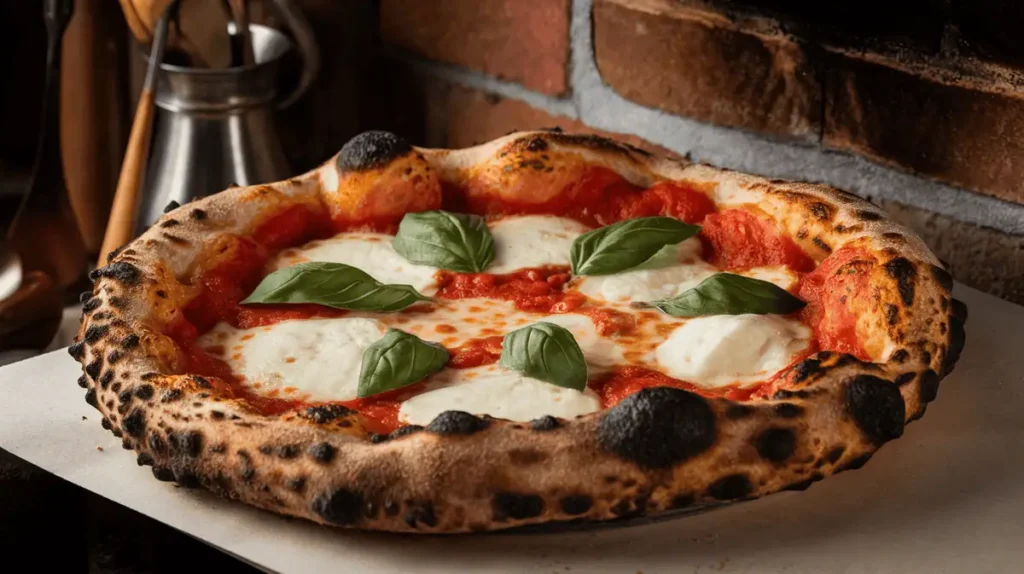
Modern pizza took form in 18th-century Naples. It was cheap, tasty, and perfect for the city’s working class. Street vendors sold flatbreads topped with tomato sauce, cheese, garlic, and herbs — all baked in hot, wood-fired ovens.
Neapolitan pizza stood out for its soft, chewy crust and vibrant San Marzano tomato sauce. Its charred edges became a signature of authenticity. This style helped define one of the world’s most iconic types of pizza.
As pizza spread across Italy and beyond, new styles emerged. Italian immigrants in the U.S. created variations like the New York slice — thinner and easier to fold. Yet Neapolitan pizza remains a global standard of quality. The AVPN (Associazione Verace Pizza Napoletana) preserves its strict preparation guidelines. For authentic recipes, visit [AllRecipes for expert insights].
The Margherita Pizza – A National Symbol
Margherita pizza is one of the most beloved and recognizable types of pizza. Its story began in 1889 when Queen Margherita of Savoy visited Naples. Chef Raffaele Esposito crafted a pizza with red tomatoes, white mozzarella, and green basil — representing the Italian flag.
The queen approved, and the Margherita pizza was born. Its strength lies in its simplicity: quality ingredients, balanced flavors, and a traditional Neapolitan crust.
Even today, Margherita pizza sets the standard for authenticity. It highlights what great pizza should be — fresh, elegant, and timeless. Whether cooked in a brick oven or prepared at home, this pizza continues to inspire food lovers.
For tips on recreating this dish, check out Fast Track Recipes for baking techniques. Among all types of pizza, Margherita proves that less can be more.
Types of Pizza Dough & Crusts – A Guide to the Perfect Base
When it comes to mastering different types of pizza, the crust is where it all begins. Whether you prefer a light, crispy bite or a deep, doughy base, the style of dough you choose defines the entire experience. This section explores the most popular crust variations, revealing how the right foundation brings out the best in every pizza.
Thin Crust vs. Thick Crust – Two Classic Types of Pizza Foundations
Among all types of pizza, the crust is what defines the first bite. Choosing between thin and thick crust is a key decision that shapes the entire experience.
Thin-crust pizzas, such as Neapolitan or New York-style, are light, airy, and crisp. Baked at high temperatures, they develop a slightly charred surface that adds flavor. These crusts support simple toppings, keeping the focus on balance and texture.
Thick-crust pizzas, like Sicilian and Chicago deep-dish, offer a hearty, doughy bite. Sicilian pizza bakes in a rectangular pan, with a fluffy center and golden base. Chicago-style deep-dish has a buttery, thick crust that supports heavy layers of cheese and tomato sauce.
Each crust suits a different taste. If you enjoy a crunchy, delicate texture, go for thin. Prefer something satisfying and rich? Choose thick. For more dough tips, visit Simply Recipes for techniques and variations.
Neapolitan, Sicilian, and New York – Foundational Pizza Dough Styles
These three crust styles are among the most iconic and represent essential types of pizza:
-
Neapolitan Pizza – Born in Naples, this dough is hand-stretched and wood-fired. The result? A soft, puffy crust with slight char. It follows strict AVPN guidelines for authenticity.
-
Sicilian Pizza – Thick and fluffy, Sicilian crust bakes in a pan. It’s crispy underneath, with rich tomato sauce and mozzarella on top.
-
New York-Style Pizza – Known for its foldable slices and chewy base, it’s baked in gas ovens and topped generously with sauce and cheese.
Each dough style creates a unique pizza experience. Want to try making these at home? See Fast Track Recipes for expert tips.
Gluten-Free and Alternative Doughs – Expanding the Types of Pizza
Many pizza lovers now seek healthier, allergy-friendly crusts. Fortunately, there are several modern dough types that still deliver great flavor and texture:
-
Cauliflower Crust – A low-carb choice made with grated cauliflower, eggs, and cheese. Crisp yet tender.
-
Whole Wheat Crust – Rich in fiber and flavor, this crust adds a nutty depth and works well with bold toppings.
-
Chickpea Flour Dough – High in protein and gluten-free, it brings a mild, earthy taste. Great for Mediterranean-style pizzas.
These innovative doughs open the door to more types of pizza — without sacrificing taste. To explore healthy crust ideas, visit [AllRecipes for inspiration].
The Endless Diversity of Pizza Types Around the World
From Naples to New York and Tokyo to São Paulo, pizza continues to evolve. Each region has contributed its own type of pizza to the world’s table. Whether you prefer traditional Italian recipes or modern interpretations, there’s a style for every taste and occasion.
Classic Pizza Styles from Around the World – A Journey Through the Top Types of Pizza
Across the globe, countless types of pizza have emerged, each shaped by regional ingredients, cultural preferences, and local techniques. From the bustling streets of Naples to the pizzerias of Tokyo and São Paulo, pizza has been reimagined in delicious ways. Let’s explore some of the most iconic styles that have stood the test of time.
Iconic Italian Types of Pizza – Neapolitan, Sicilian, and Roman
Italy is the birthplace of many traditional types of pizza. Each region offers unique flavors, crusts, and baking techniques that shaped global pizza culture.
-
Neapolitan Pizza: Made with San Marzano tomatoes, fresh mozzarella, and a chewy, blistered crust. This pizza is soft, simple, and highly regulated by AVPN standards.
-
Sicilian Pizza: Known for its thick, spongy base, this pizza bakes in a rectangular tray. It has a crispy bottom and is often topped with tomato sauce and mozzarella.
-
Roman Pizza (Pizza al Taglio): Baked in large trays and sold by the slice, this pizza has a thin, crispy crust with creative toppings.
These three Italian styles represent the roots of modern pizza. To explore more traditional recipes, visit [Simply Recipes for Italian pizza ideas].
Distinct American Pizza Types – New York, Chicago, and Detroit
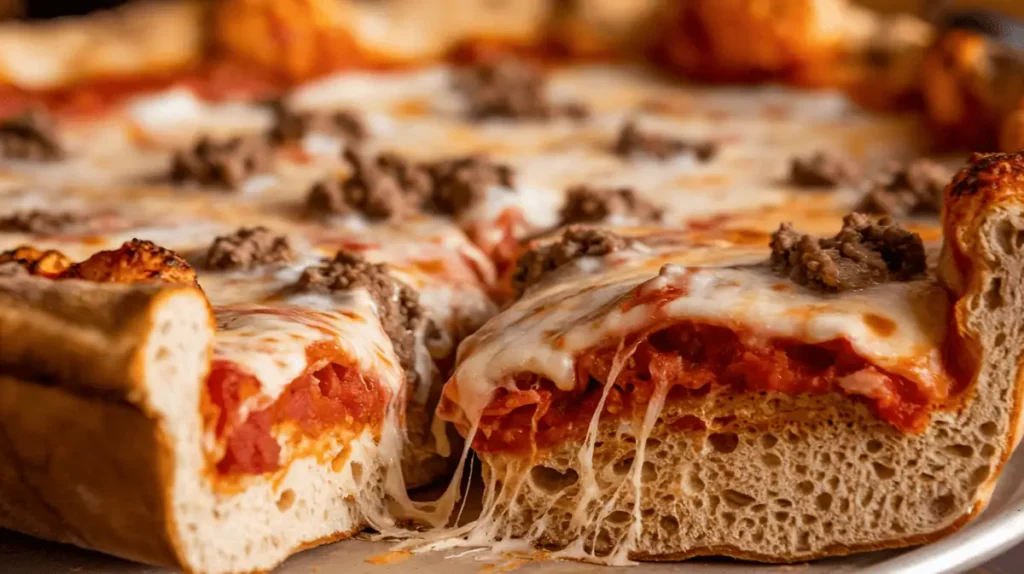
The United States has developed several bold and recognizable types of pizza. These styles reflect local culture and flavor preferences.
-
New York-Style Pizza: Large, foldable slices with a thin, chewy crust and light tomato sauce. Topped with shredded mozzarella and baked in gas ovens.
-
Chicago Deep Dish: Thick, buttery crust filled with cheese, chunky tomato sauce, and toppings layered in reverse order.
-
Detroit-Style Pizza: Square-shaped with a thick, airy base. The edges are lined with caramelized cheese, making it one of the most flavorful types of pizza in America.
Each American pizza style emphasizes bold ingredients and generous portions. To learn how to make these at home, explore [Fast Track Recipes for American pizza guides].
Global Variations – Unique Regional Types of Pizza
As pizza spread worldwide, local ingredients inspired new and unexpected types of pizza. These regional twists showcase cultural creativity:
-
Japan: Seafood pizzas with shrimp, squid, and Japanese mayo deliver a unique umami profile.
-
Brazil: Toppings like green peas, catupiry cheese, and hearts of palm make Brazilian pizza both colorful and rich.
-
India: Spicy paneer, tandoori chicken, and curry sauces dominate Indian-style pizzas, offering bold and vibrant flavors.
These global types of pizza reflect how adaptable this dish is across different cultures. Want to try international versions? Check out AllRecipes for global pizza inspiration.
Gourmet and Specialty Types of Pizza – Creative Twists on a Classic Dish
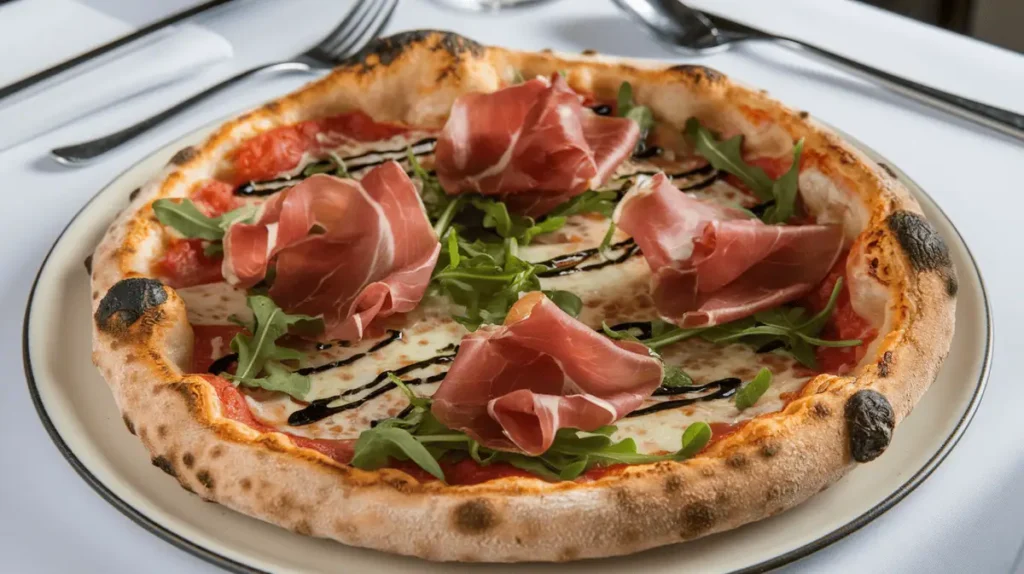
Beyond the traditional favorites, gourmet and specialty types of pizza bring innovation and indulgence to the table. These unique creations blend high-end ingredients, global inspirations, and culinary creativity to offer something truly exceptional. Whether you’re craving rich flavors or artistic presentation, these pizzas elevate the classic dish to a whole new level.
Truffle and Prosciutto – The Luxurious Type of Pizza
Some types of pizza go beyond tradition to deliver a refined experience. Truffle and prosciutto pizza is one of the most indulgent.
Truffle oil adds a rich, earthy aroma, while thin prosciutto brings a delicate, salty flavor. These toppings rest on a crispy crust layered with mozzarella, Parmesan, and fresh arugula. The result is elegant, balanced, and deeply flavorful.
To recreate this specialty pizza at home, use authentic Italian prosciutto and high-quality truffle oil. Pair it with a light arugula salad for contrast.
Seafood Pizzas – A Fresh and Savory Pizza Style
Seafood-based pizzas bring new life to classic dough. Toppings like shrimp, smoked salmon, and calamari add sweetness and texture.
A white garlic sauce or pesto base complements seafood better than tomato sauce. Cheeses like mozzarella, ricotta, or goat cheese enhance flavor without overpowering it. Chefs often add capers or dill for brightness.
Bake at high heat to keep seafood tender and the crust crispy.
Vegan and Plant-Based Pizzas – A Modern Type of Pizza for Everyone
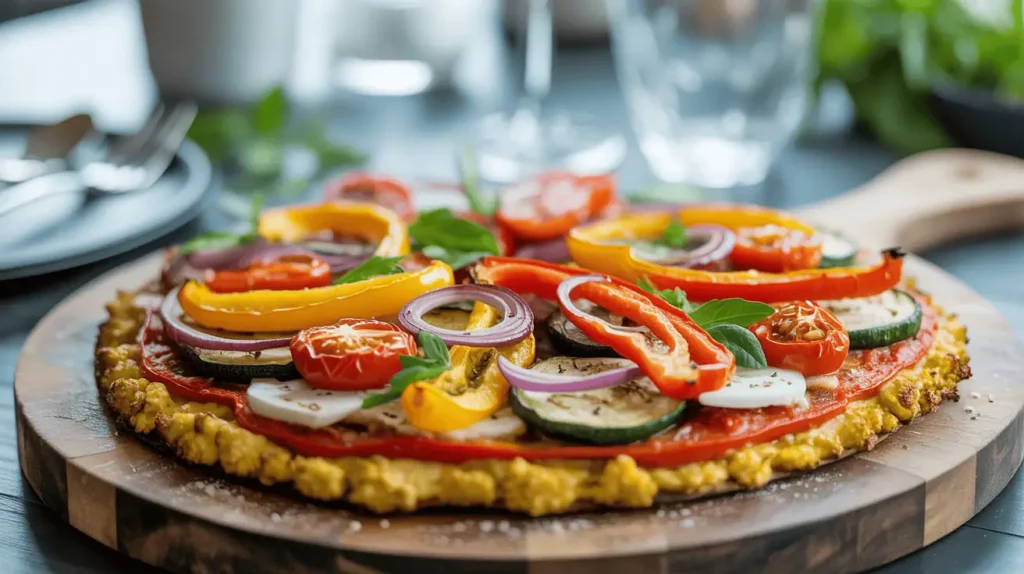
Among the growing types of pizza, vegan options are gaining popularity. These pizzas skip dairy but remain rich in taste and texture.
Common substitutes include:
-
Cashew mozzarella
-
Almond ricotta
-
Nutritional yeast sauces
Popular toppings include roasted vegetables, sun-dried tomatoes, and fresh herbs. A whole wheat or cauliflower crust adds nutrition without sacrificing crunch.
Vegan pizzas offer variety for plant-based eaters or those seeking lighter alternatives. For more ideas, visit Fast Track Recipes for plant-based pizza inspiration.
TikTok-Inspired Pizza Trends – Viral Types of Pizza in 2025
Social media platforms like TikTok have popularized new types of pizza, blending creativity with convenience.
Some of the top viral trends include:
-
Tortilla pizzas: thin, quick, and perfect for air fryers
-
Pesto-crust pizzas: adding herby flavor from the base up
-
Pizza bowls: crustless and microwave-ready, ideal for low-carb diets
These trends reflect how pizza continues to evolve. Want to try one? Don’t miss our Lazy Girl’s Pizza Bowl recipe — quick, cheesy, and stress-free.
Must-Try Toppings and Combinations – Essential Add-Ons for All Types of Pizza
Toppings are where creativity shines in every type of pizza. From timeless ingredients to unexpected flavor pairings, choosing the right toppings transforms a simple crust into a personalized masterpiece. In this section, we explore classic favorites, bold combinations, and even sweet takes that showcase just how diverse pizza can be.
Classic Pizza Toppings That Never Go Out of Style
Many toppings stand the test of time because they strike a perfect balance of flavor and texture. Some of the most loved ingredients include pepperoni, mushrooms, olives, bell peppers, and onions.
Mozzarella remains essential across most types of pizza. It melts evenly and stretches beautifully. Paired with a tomato-based marinara, these toppings shine without overpowering the crust.
Whether you prefer thin, thick, or stuffed crusts, classic toppings bring comfort and familiarity.
Creative and Unexpected Topping Ideas
Some types of pizza shine with bold, surprising pairings. Adventurous eaters often experiment with ingredients that push flavor boundaries.
Try these combinations:
-
Goat cheese and honey – Sweet and tangy for a rich, balanced bite
-
Figs and prosciutto – A sophisticated take on sweet-meets-savory
-
Spicy chorizo and pineapple – A fiery twist on the Hawaiian classic
These toppings work best when made with fresh, high-quality ingredients. Looking for inspiration? Explore Fast Track Recipes for bold pizza ideas.
Dessert Pizzas – A Sweet Type of Pizza Worth Trying
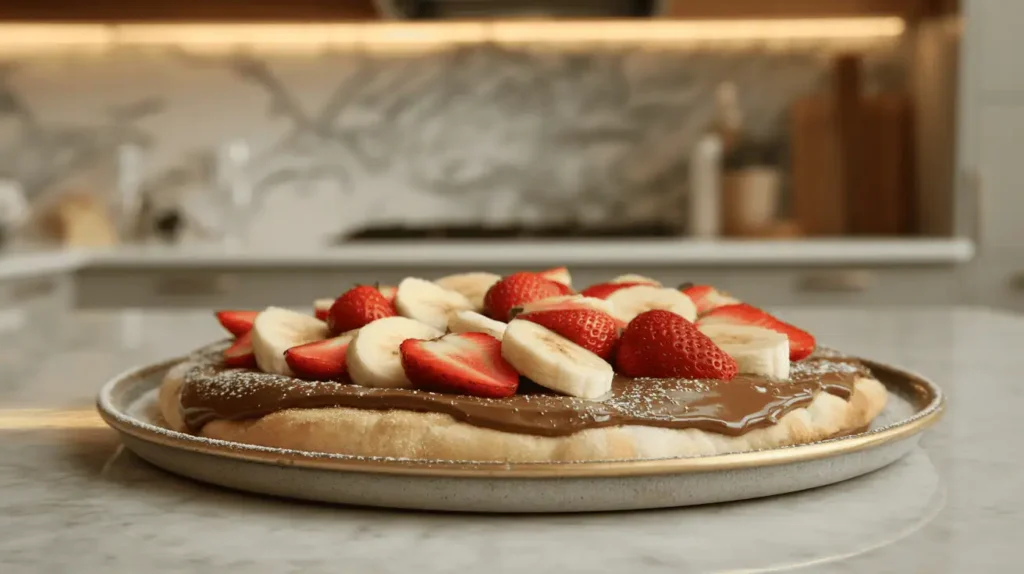
Pizza isn’t just savory — it can be sweet too. Dessert pizzas bring fun and indulgence to the table, using soft dough bases like cookie or cinnamon roll crusts.
Popular sweet toppings include:
-
Nutella and strawberries – Creamy and fruity
-
Bananas and caramel – Warm and comforting
-
Ricotta and honey – Light, tangy, and naturally sweet
Enhance the flavor with chocolate chips, crushed nuts, or a sprinkle of powdered sugar. For more dessert pizza inspiration, Check out [ sweet pizza ideas.
Conclusion – Toppings Define Every Type of Pizza Experience
The choice of toppings transforms each slice into a unique creation. From timeless classics to creative fusions and sweet experiments, every type of pizza becomes a blank canvas for flavor. Whether you keep it simple or go bold, great toppings elevate every bite.
The Best Cheeses for Every Type of Pizza – A Flavor Guide
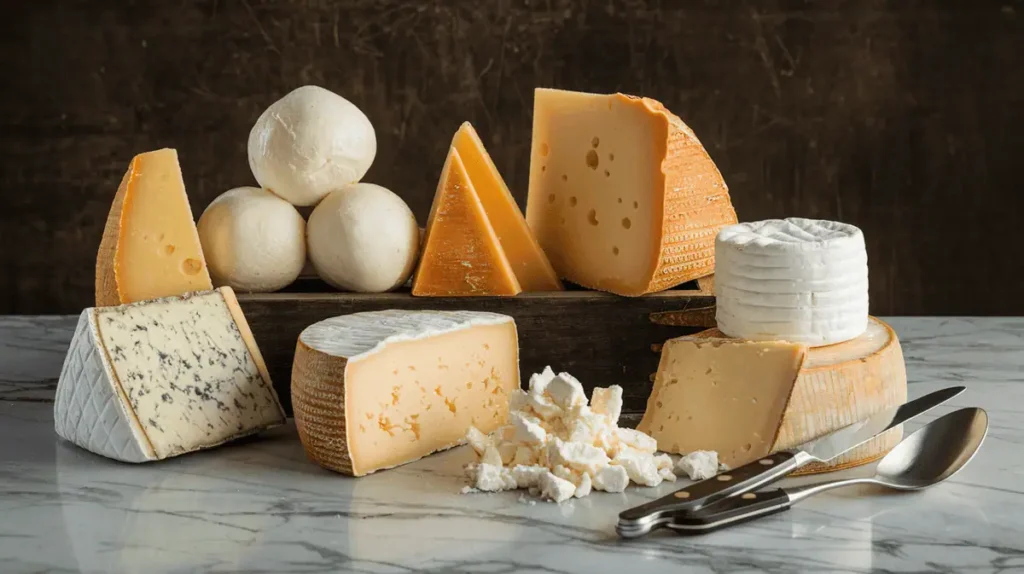
When it comes to the most essential ingredients, cheese plays a starring role in nearly all types of pizza. The texture, melt, and flavor of cheese can elevate a basic slice or define a regional specialty. This section dives into the most popular pizza cheeses—both traditional and modern—offering options for every preference, including plant-based choices.
Mozzarella – The Essential Cheese Across All Types of Pizza
Mozzarella is the most widely used cheese for pizza — and for good reason. It melts perfectly, stretches well, and has a mild, creamy flavor.
Fresh mozzarella, used in Neapolitan pizza, creates a soft, slightly tangy bite that pairs beautifully with tomato sauce and charred crusts. This version, often made with buffalo milk, carries a PDO certification in Italy, guaranteeing quality and tradition.
Low-moisture mozzarella is common on New York-style and American pizzas. It browns evenly and has a firmer texture, perfect for large, thin slices.
No matter the style, mozzarella supports the structure and flavor of nearly all types of pizza. To learn more about its variations, check out mozzarella guide .
Alternative Cheeses – Unique Pairings for Specialty Pizza Types
Beyond mozzarella, other cheeses add character and contrast. Chefs often mix these to enhance specific types of pizza.
Try these flavorful options:
-
Provolone – Slightly tangy, ideal for Italian-American pizzas
-
Parmesan – Aged and salty, best used as a finishing touch
-
Gorgonzola – Bold and sharp, perfect with fruit-based toppings
-
Ricotta – Creamy and mild, great for white or veggie pizzas
Each cheese introduces new textures and aromas. Want to try creative blends? Explore pairing ideas.
Vegan Cheeses – Dairy-Free Options for Plant-Based Pizza Types
Vegan pizza has evolved thanks to better dairy-free cheese alternatives. These products now offer satisfying flavor, melt, and stretch.
Top plant-based options include:
-
Cashew-based mozzarella – Smooth, creamy, and mild
-
Almond ricotta – Nutty, light, and great on veggie pizzas
-
Coconut oil shreds – Stretchy, meltable, and versatile
Combining two or more vegan cheeses often improves flavor balance.
Conclusion – Choosing the Right Cheese for Your Pizza Type
The cheese you choose defines the taste, texture, and success of each slice. Whether you stick with classic mozzarella or explore bold alternatives, the right pairing enhances all types of pizza. Great cheese brings your pizza to life — and makes every bite memorable.
Beyond Tomato Sauce – Creative Sauces for All Types of Pizza
While dough and cheese are crucial, it’s often the sauce that defines the character of a pizza. From classic tomato marinara to bold alternatives like garlic cream or smoky barbecue, each type of sauce brings its own flair. In this section, we explore the most popular and creative pizza sauces that complement a wide range of crusts and toppings
Classic Marinara – A Must for Traditional Pizza Types
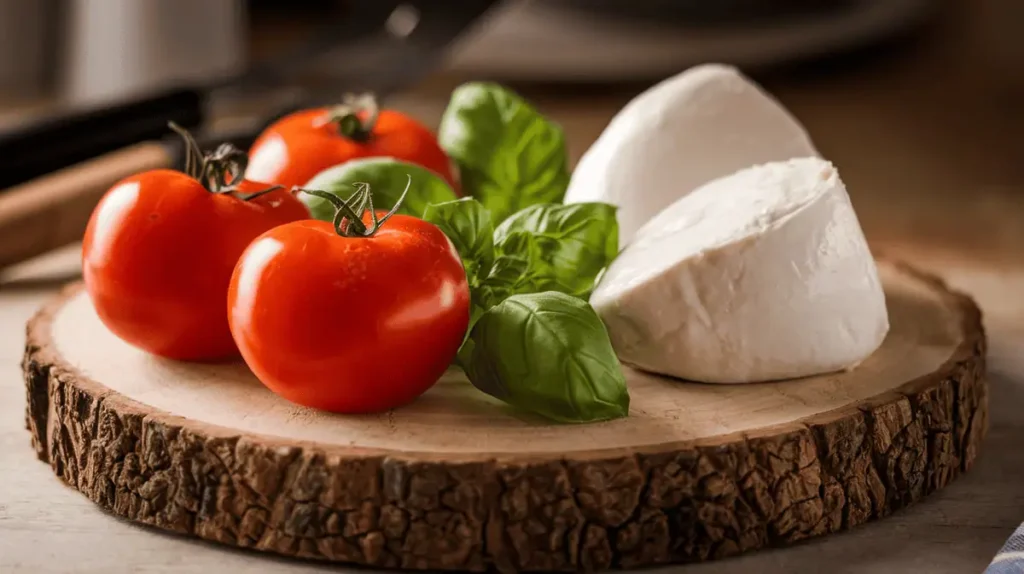
Marinara is the most traditional and widely used sauce across many types of pizza. Its charm lies in its simplicity.
Made from San Marzano tomatoes, garlic, olive oil, and basil, this sauce offers a sweet, tangy, and aromatic flavor. Neapolitan pizza makers follow strict DOP guidelines to preserve its authenticity.
Unlike pasta sauces, pizza marinara skips sugar and extras. This allows the natural taste of tomatoes to shine. For more on this classic, Discover guide to Neapolitan pizza.
White Garlic Sauce – A Rich Alternative for Modern Pizza Types
White garlic sauce provides a creamy base for many gourmet types of pizza. Made with roasted garlic, butter, cream, and Parmesan, it complements toppings like spinach, chicken, or mushrooms.
For a healthier twist, swap cream with Greek yogurt or plant-based milk. This sauce enhances flavor without overwhelming the toppings.
Pesto, BBQ, and Other Unique Pizza Sauces
Many non-traditional sauces now define modern types of pizza. These flavorful bases let chefs create original combinations.
-
Pesto – Basil, pine nuts, Parmesan, garlic, and olive oil form a nutty, herby base.
-
Barbecue Sauce – Smoky and tangy, it pairs well with grilled chicken and caramelized onions.
-
Buffalo Sauce – Spicy and bold, ideal for fans of heat and blue cheese toppings.
-
Hummus – Creamy and savory, great for plant-based and Mediterranean-style pizzas.
Trying new sauces transforms a basic dough into something memorable.
Conclusion – The Right Sauce for Every Type of Pizza
Sauce is more than a base — it’s a defining element of flavor. Whether you love marinara, creamy garlic, or spicy BBQ, each choice enhances the final result. Matching your cheese and sauce well creates perfect harmony in all types of pizza.
Perfect Pizza Pairings – Drinks & Sides for Every Type of Pizza
Pairing the right drink with your favorite type of pizza enhances every bite. Whether you’re enjoying a classic Margherita, a spicy veggie combo, or a rich gourmet slice, refreshing beverages bring balance and elevate the meal.
Options like sparkling water with citrus, fruit-infused teas, or lightly sweetened juices can refresh the palate and complement bold flavors. These pairings are ideal for casual lunches, family dinners, or themed pizza nights.
Choosing the right drink doesn’t just quench your thirst—it completes the experience.
Refreshing Drinks to Pair with Every Type of Pizza
Pairing your pizza with the right drink enhances the overall dining experience. Fortunately, you don’t need alcohol to enjoy a delicious and complementary beverage.
-
Sparkling water with citrus is a clean, crisp option that balances out rich cheeses and savory toppings.
-
Homemade iced tea, whether lemon, mint, or berry-infused, adds a refreshing and slightly sweet contrast to spicy or smoky pizza flavors.
-
Natural fruit juices, like cold-pressed apple, mango, or pomegranate, work well with veggie, plant-based, or dessert pizzas.
-
Cucumber or basil-infused water is ideal for lighter pizzas, such as Margherita or gluten-free varieties.
These drinks cleanse the palate and bring out the distinct notes of different types of pizza without overpowering the flavors.
Best Side Dishes for Pizza Night
A great pizza meal doesn’t stop at the pie. Adding a well-matched side dish brings balance and variety to the table.
-
Mixed green salads with lemon vinaigrette refresh the palate and complement any pizza style.
-
Roasted vegetables, like zucchini, mushrooms, or eggplant, bring warmth and depth to the meal.
-
Garlic knots or herb focaccia add a flavorful, doughy element that pairs perfectly with tomato-based sauces.
-
For dipping, offer homemade marinara, cashew-based cheese sauce, or basil pesto.
Whether you’re serving a casual lunch or a family-style dinner, these drink and side pairings ensure that every type of pizza shines in full flavor.
Secrets to Making the Perfect Pizza at Home – Techniques for All Types of Pizza
Mastering the foundation of any pizza starts with choosing the right flour and yeast. Different types of pizza require different textures—from chewy Neapolitan to crispy Roman—and that begins with your dough. By understanding how flour strength and yeast type influence structure and flavor, home bakers can confidently create a base that suits any style. Whether you’re preparing a thin crust or a thick pan pizza, starting your dough the right way is essential to achieving restaurant-quality results at home.
Choosing the Right Flour and Yeast – Start Your Dough the Right Way
The base of every great pizza begins with quality dough. Therefore, choosing the right flour and yeast is essential for success.
Tipo 00 or bread flour yields a chewy, elastic crust, perfect for Neapolitan or New York-style pizzas. In contrast, all-purpose flour creates a thinner, softer texture — ideal for tavern-style pizza.
As for yeast:
-
Active dry yeast must be proofed before mixing.
-
Instant yeast blends directly into the flour.
-
Sourdough starters offer natural fermentation, adding depth and a tangy flavor.
Moreover, letting the dough rest overnight boosts texture and flavor. As a result, these steps help create the best version of many types of pizza.
Baking Temperature and Tools – Get the Crust Just Right
Once your dough is prepped, baking it correctly is just as important. Traditional wood-fired ovens reach up to 800°F (425°C), cooking pizza in under two minutes.
However, most home ovens cap at 500°F (260°C). To mimic professional results:
-
Preheat for at least 30 minutes
-
Use a pizza stone or steel for better heat retention
-
Place the pizza on the lowest rack for even browning
In addition, some cooks opt for cast-iron skillets or grills to achieve a smoky, charred finish.
Tips for a Crispier Crust – Final Touches That Matter
A crispy crust adds the perfect finishing touch to all types of pizza. It depends not only on baking but also on preparation.
Follow these key techniques:
-
Roll the dough evenly to avoid burnt spots
-
Brush olive oil on the edges before baking
-
Bake on a perforated pan or oven rack for more airflow
Finally, allow the pizza to cool for 2–3 minutes before serving. This helps the crust firm up and the flavors to settle.
Pizza Baking Methods – Tools and Heat for All Types of Pizza
The way pizza is baked plays a crucial role in its final texture and flavor. Whether you’re aiming for a bubbly Neapolitan crust or a golden, crispy base, the heat source you choose makes all the difference. From traditional wood-fired ovens to modern home setups, each method offers unique advantages for different types of pizza. Understanding how temperature and tools affect baking results will help you recreate pizzeria-quality pies in your own kitchen.
Wood-Fired Ovens vs. Home Ovens – Heat Makes the Difference
Wood-fired ovens are the gold standard for Neapolitan-style pizzas. These ovens reach over 800°F (425°C) and cook pizzas in under two minutes.
Thanks to this high heat, the crust becomes airy, chewy, and slightly charred — a signature of certain traditional types of pizza. Additionally, burning wood adds a smoky flavor that’s hard to replicate.
However, most home cooks use standard ovens. Although limited to 500°F (260°C), they still deliver great results. To improve performance, use a pizza stone or steel and preheat for at least 30 minutes. This ensures even heat and prevents soggy crusts.
Why a Pizza Stone Enhances All Types of Pizza
A pizza stone helps replicate pizzeria results at home. Made from ceramic or cordierite, it stores heat and cooks the crust evenly.
To use it effectively:
-
Preheat for 30–45 minutes at 500°F (260°C)
-
Use a pizza peel to slide the dough onto the hot surface
-
Never clean with soap; wipe it clean or scrape after use
Alternatively, try a pizza steel, which retains heat even better and creates a crispier base.
Grilling Pizza – Intense Heat for Crispy Crusts
Grilled pizza delivers smoky, restaurant-style flavor from your backyard. It’s ideal for thin-crust types of pizza, thanks to direct, high heat.
Here’s how to grill it right:
-
Preheat the grill to 450–500°F (230–260°C)
-
Lightly oil the grates to prevent sticking
-
Cook the dough for 1–2 minutes
-
Flip, add toppings, and close the lid to melt cheese
-
Remove once the crust is golden and crisp
This method enhances both flavor and texture.
Conclusion – Choose the Right Baking Method for Your Pizza Type
Each baking method has its strengths. Whether you’re using a wood-fired oven, pizza stone, or grill, the right setup ensures your type of pizza comes out just the way you want — crisp, hot, and full of flavor.
Healthier Pizza Alternatives – Nutritious Options for All Types of Pizza
As more people seek balance between flavor and wellness, healthier pizza alternatives are becoming increasingly popular. From fiber-rich whole wheat crusts to low-carb cauliflower bases, these nutritious options cater to a variety of dietary needs—without sacrificing the joy of pizza. Whether you’re watching carbs or boosting your veggie intake, there’s a better-for-you base that fits every type of pizza style.
Whole Wheat and Cauliflower Crusts – Better Bases for Every Pizza Style
For pizza lovers seeking healthier choices, whole wheat and cauliflower crusts are top options. These alternatives support both flavor and nutrition.
-
Whole wheat crust is rich in fiber and nutrients. Its nutty taste pairs well with roasted veggies and lean toppings.
-
Cauliflower crust is low-carb and gluten-free. Made with cauliflower, eggs, and cheese, it offers a crispy base with fewer carbs.
These crusts suit keto, low-calorie, and plant-based versions of various types of pizza. For recipes, check out [Serious Eats for healthy crust ideas].
👉 Bonus: Try our Lazy Girl Pizza Bowls — no crust, no stress!
Low-Calorie Toppings – Keep It Light Without Losing Flavor
Smart topping choices can reduce calories without sacrificing taste. Instead of processed meats or excess cheese, use fresh, nutrient-dense ingredients.
Top light toppings include:
-
Tomatoes, arugula, and bell peppers for vitamins and antioxidants
-
Grilled chicken or turkey for lean protein
-
Ricotta or goat cheese as lower-fat alternatives to mozzarella
Moreover, using a thin crust and less cheese also cuts calories.
Protein-Rich Toppings – Boost Nutrition in Every Slice
Protein-packed toppings improve satisfaction and balance. Rather than using fatty meats, consider lean, plant-based, or egg-based proteins.
Great options include:
-
Grilled chicken, tofu, or tempeh for lean, complete proteins
-
Eggs for a breakfast-style pizza with spinach or feta
-
Chickpeas or lentils for added protein and fiber
These additions fit well with many healthy types of pizza. For recipes, explore Fast Track Recipes for protein-rich pizzas.
Conclusion – A Better Pizza for Every Lifestyle
Healthy doesn’t mean boring. By switching to whole wheat crusts, fresh toppings, and lean proteins, you can create nutritious versions of your favorite types of pizza. The Pizza Edition proves that flavor and health can go hand in hand — one slice at a time.
Best Pizza Restaurants Around the World – Must-Visit Places for All Types of Pizza
For true pizza lovers, exploring the best pizzerias around the world is more than a culinary adventure—it’s a journey through the most iconic types of pizza ever created. From the birthplace of Neapolitan pizza in Naples to modern wood-fired spots across continents, these restaurants celebrate tradition and innovation. If you’re curious about where to enjoy authentic or creative slices, these must-visit places deliver every style and flavor imaginable.
Famous Pizzerias in Italy – Where Pizza Tradition Was Born
Italy is the cradle of the world’s most iconic types of pizza. Across the country, each region preserves unique traditions that continue to inspire pizza lovers.
In Naples, L’Antica Pizzeria da Michele has served Neapolitan pizza since 1870. Known for its charred crust and creamy mozzarella, it attracts fans globally. Nearby, Pizzeria Sorbillo offers an equally revered experience, with its light, airy dough and top-tier ingredients.
Meanwhile in Rome, the focus shifts to Pizza al Taglio — rectangular slices sold by weight. At Pizzarium, chef Gabriele Bonci reinvents the style using gourmet toppings and ancient grains.
Top-Rated U.S. Pizzerias – Diverse Styles Across America
The U.S. offers an impressive variety of pizza styles. From thin New York slices to deep-dish Chicago pies, each city contributes to the evolution of modern types of pizza.
In Brooklyn, Di Fara Pizza is a cult favorite, thanks to its hand-crafted pies and imported ingredients. Over in Manhattan, Joe’s Pizza is a local icon for a classic New York slice.
In Chicago, Lou Malnati’s and Pequod’s serve thick, buttery crusts topped with layers of cheese and sauce. Out west, Pizzeria Bianco in Phoenix, run by James Beard Award winner Chris Bianco, sets the gold standard for wood-fired artisanal pizza.
Global Pizza Hotspots – Local Takes on Classic Types of Pizza
Beyond Italy and the U.S., pizza has flourished worldwide, blending global flavors with traditional techniques.
In Japan, Seirinkan in Tokyo serves minimalist Neapolitan-style pizzas, prized for their high-quality ingredients. In Brazil, Bráz Pizzaria stands out with its wood-fired pies topped with Catupiry, a beloved local cheese.
Meanwhile, in Australia, 400 Gradi in Melbourne—founded by world champion pizzaiolo Johnny Di Francesco—honors true Neapolitan methods while adding modern flair.
These destinations prove that no matter the region, pizza remains a universally loved dish.
Conclusion – Great Pizza Knows No Borders
From Tokyo to Naples and New York to São Paulo, each region brings something new to the world of pizza. Whether you enjoy classic recipes or experimental toppings, there’s a type of pizza waiting to be discovered — and savored — somewhere in the world.
Pizza Trends and Innovations – The Future of All Types of Pizza
As pizza continues to grow in global popularity, technology and innovation are reshaping how we enjoy every type of pizza. From AI-driven customization tools to sustainable ingredients and futuristic delivery methods, the pizza world is embracing change. This section explores how emerging trends are redefining not only what we eat, but how we experience our favorite types of pizza.
AI-Customized Pizzas – Personalization Meets Technology
Artificial intelligence is transforming how we create and order pizza. New digital tools help customers build their perfect slice based on personal preferences.
For instance, Domino’s offers an AI-powered ordering system using voice recognition to streamline the process. Meanwhile, some startups use machine learning to suggest topping combinations based on flavor trends and dietary needs.
As a result, AI enhances personalization and reduces waste by predicting what people want. This innovation also improves the customer journey for all types of pizza lovers.
The Rise of Plant-Based and Lab-Grown Options
As plant-based diets gain popularity, the pizza world is adapting fast. More pizzerias now serve vegan cheeses, vegetable-based crusts, and realistic meat alternatives.
Brands like Miyoko’s Creamery and Violife create dairy-free cheeses with great melt and flavor. At the same time, Beyond Meat and Impossible Foods deliver plant-based sausage and pepperoni that taste surprisingly authentic.
Lab-grown meats are also gaining traction. Startups like Memphis Meats and Eat Just are developing cruelty-free proteins that could soon top your favorite pizza.
These advances help reduce emissions and meet new dietary expectations.
Pizza Automation and Delivery Tech – Speed Meets Precision
Automation is improving every part of the pizza-making process. Some businesses now use robots to prepare, bake, and serve pizzas with high accuracy.
For example, Zume Pizza pioneered robotic sauce-spreaders and topping arms before closing operations. Today, places like Pazzi in Paris continue this trend with fully automated kitchens.
Delivery is also changing fast. AI-driven tracking, drone deliveries, and self-driving vehicles are now being tested by major brands like Domino’s and Uber Eats.
This evolution makes pizza faster and more accessible, especially for customized or fast-delivery types of pizza.
Conclusion – A Bold New Era for All Types of Pizza
From robot chefs to lab-grown toppings, innovation is shaping how pizza is made and enjoyed. Whether you love tradition or tech, the future promises endless possibilities across all types of pizza.
FAQs – All You Need to Know About Types of Pizza
Before diving into the oven, many pizza lovers have questions about the different types of pizza they see on menus or in recipes. From baking methods to ingredient choices, this FAQ section answers the most common queries to help you master every style — whether you’re new to pizza-making or a seasoned home chef.
What’s the difference between Neapolitan and New York-style pizza?
These two types of pizza differ in crust, texture, and baking method.
Neapolitan pizza, from Naples, has a soft, airy crust with a charred edge. It bakes in wood-fired ovens at over 800°F (425°C) in just 90 seconds. Toppings are simple: San Marzano tomatoes, fresh mozzarella, basil, and olive oil.
New York-style pizza has a thinner, firmer crust. It’s baked in gas ovens and folded easily, with shredded mozzarella and seasoned tomato sauce.
Can you make pizza without an oven?
Absolutely. There are several methods to bake pizza without a traditional oven.
-
Stovetop: Cook the dough in a skillet with a lid. Flip once before adding toppings.
-
Grill: Use medium-high heat. Grill the dough, flip, then top and finish cooking.
-
Air fryer: Ideal for thin or pre-cooked dough. Crisp your pizza in minutes at 375°F (190°C).
These alternatives still deliver delicious results.
What’s the best cheese for homemade pizza?
Mozzarella remains the top choice for any type of pizza, thanks to its melt and stretch.
Other excellent options include:
-
Fresh mozzarella – Creamy and mild, ideal for Neapolitan pizza.
-
Low-moisture mozzarella – Best for New York-style pies.
-
Provolone – Slightly sharp, often blended with mozzarella.
-
Parmesan – Adds nutty, salty depth when sprinkled after baking.
-
Ricotta – Soft and slightly sweet, perfect for white pizzas.
How do I make my pizza crust crispy?
Getting a crisp crust depends on heat, flour, and technique.
-
Use high-protein flour like bread flour or Tipo 00.
-
Preheat your oven and pizza stone to 500°F (260°C) or more.
-
Stretch the dough thin and avoid too much sauce or toppings.
-
Brush olive oil on the edge of the crust before baking.
What are some creative toppings to try?
Unique toppings can make your pizza unforgettable. Here are five ideas:
-
Fig and prosciutto – Sweet and salty with a drizzle of balsamic glaze.
-
Goat cheese and honey – Creamy meets sweet.
-
Truffle oil and mushrooms – Earthy and aromatic.
-
Smoked salmon and crème fraîche – Inspired by bagels and lox.
-
Egg and pancetta – A rich, breakfast-style pizza.
Find more at Fast Track Recipes for pizza topping ideas.
What’s the healthiest type of pizza?
A healthy pizza uses smart ingredients and balanced portions.
-
Choose whole wheat or cauliflower crusts for more fiber.
-
Use homemade tomato sauce to cut added sugars.
-
Top with fresh vegetables like spinach, bell peppers, and mushrooms.
-
Add lean proteins such as grilled chicken or tofu.
-
Use less cheese and opt for aged varieties like Parmesan.
Conclusion – Why the World Can’t Get Enough of Every Type of Pizza
From weeknight dinners to international food festivals, pizza has secured its place as one of the most universally loved dishes. Its ability to adapt to every culture, diet, and trend makes it far more than just a meal — it’s a shared experience. In this final section, we’ll reflect on why the world remains endlessly fascinated by every type of pizza.
A Dish Loved Across the Globe
Pizza is loved worldwide for its variety, accessibility, and comfort. From a traditional Margherita in Naples to a cheesy deep-dish slice in Chicago, every region has its own take on this iconic dish.
Because it starts with a simple base—dough, sauce, and cheese—it invites endless variations. That’s why families enjoy it at home, chefs reinvent it in restaurants, and foodies keep experimenting with creative toppings.
More importantly, pizza continues to evolve. Whether it’s plant-based, gourmet, or powered by artificial intelligence, every innovation proves that pizza is more than just food—it’s a cultural phenomenon.
Pizza in 2025 – Innovation Baked Into Every Slice
In 2025, pizza is bolder and more diverse than ever. We now have AI-designed toppings, lab-grown proteins, and viral creations like crustless pizza bowls.
Still, one thing remains constant: pizza brings people together. No matter the trend or the ingredients, it keeps its place at the center of shared meals, celebrations, and cozy nights in.
Exploring New Types of Pizza Is a Journey
Trying new types of pizza is about more than taste. It’s a chance to discover global cultures, cooking methods, and flavor pairings.
Whether you’re learning to make the perfect crust at home or searching for the best local slice during your travels, every pizza offers a unique experience.
So keep exploring. The next great type of pizza might be just one bite away.
